Nizam of Hyderabad
| Nizam of Hyderabad | |
|---|---|
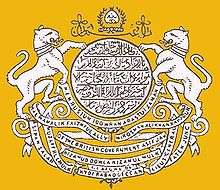 Coat of Arms of Hyderabad State | |
| Details | |
| Style | His Exalted Highness |
| First monarch | Qamar-ud-din Khan |
| Last monarch | Osman Ali Khan |
| Formation | 31 July 1724 |
| Abolition | 17 September 1948 |
| Residence | Chowmahalla Palace |
| Pretender(s) | Mukarram Jah |
The Nizam of Hyderabad (Nizam-ul-Mulk, also known as Asaf Jah) was a monarch of the Hyderabad State, now divided into Telangana state, Hyderabad-Karnataka region of Karnataka and Marathwada region of Maharashtra. Nizam, shortened from Nizam-ul-Mulk, meaning Administrator of the Realm, the title of the sovereigns of Hyderabad State, was the premier Prince of India, since 1724, belonging to the Asaf Jah dynasty.
The Asaf Jah Dynasty was founded by Mir Qamar-ud-Din Siddiqi, a viceroy of the Deccan under the Mughal Empire from 1713 to 1721. He intermittently governed the region after Aurangzeb's death in 1707. In 1724, Mughal control weakened, and Asaf Jah became virtually independent of them; Hyderabad would then become a tributary of the Maratha Empire, losing a series of battles for independence through the 18th century.
When the British achieved paramountcy over India, the Nizams were allowed to continue to rule their princely states as client kings. The Nizams retained internal power over Hyderabad State until 17 September 1948 when Hyderabad was integrated into the new Indian Union.[1] The Asaf Jah dynasty had only seven rulers; however there was a period of 13 years after the rule of the first Nizam when three of his sons (Nasir Jung, Muzafar Jung and Salabath Jung) ruled. They were not officially recognised as the rulers.
Seven Nizams ruled Hyderabad for two centuries until 1947. The Asaf Jahi rulers were great patrons of literature, art, architecture, and culture, and rich food. The Nizams patronized aspects of a Persianate society, copied from their Turco-Mongol Mughal overlords, and which became central to the Hyderabadi Muslims identity.
Hyderabad
By the time of its annexation by India, Hyderabad was the largest and most prosperous state of all the princely states. It covered 82,698 square miles (214,190 km2) of fairly homogeneous territory and had a population of roughly 16.34 million people (as per the 1941 census), of which a majority (85%) was Hindu. Hyderabad State had its own army, airline, telecommunication system, railway network, postal system, currency and radio broadcasting service. In spite of the overwhelming Hindu majority, Hindus were severely under-represented in government, police and the military. [2] Of 1765 officers in the State Army, 1268 were Muslims, 421 were Hindus, and 121 others were Christians, Parsis and Sikhs. Of the officials drawing a salary between Rs.600-1200 per month, 59 were Muslims, 5 were Hindus and 38 were of other religions. The Nizam and his nobles, who were mostly Muslims, owned 40% of the total land in the state.[3][4]
History
Etymology
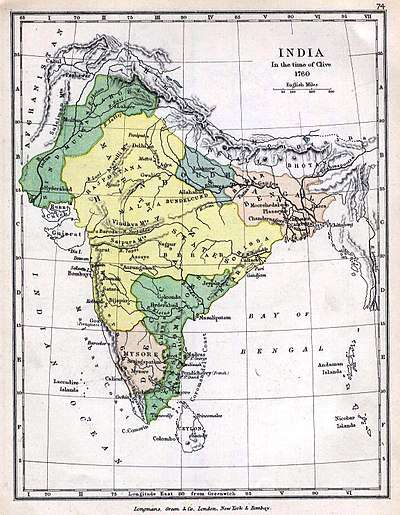
The name Nizam also spelled as Nezam, comes from Urdu (نظام) /nɪˈzɑːm/, which itself is derived from the ancient Arabic language niẓām which means "order" or "arrangement".[5] Nizām-ul-mulk was a title first used in Urdu around 1600 to mean Governor of the realm or Deputy for the whole Empire. The word is derived from the Arabic language, as in Abu Ali Hasan ibn Ali Tusi (11 April 1018 – 14 October 1092), better known by his honorific title of Nizam al-Mulk (Arabic: نظام الملک, "Order of the Realm").
Descent
According to Sir Roper Lethbridge in "The Golden Book of India"—( 1893), the Nizams are lineally descended from the First Caliph Abu Bakr, the successor of the Prophet Muhammed.[6] The family of Nizams in India is descended from Abid Khan, a Turkoman from Samarkand, whose lineage is traced to Sufi Shihab-ud-Din Suhrawardi ( 1154–91) of Central Asia. In early 1650s, on his way to hajj, Abid Khan stopped in Deccan, where the young prince Aurangzeb, then Governor of Deccan, cultivated him. Abid Khan returned to the service of Aurangzeb to fight in the succession wars of 1657–58. After Aurangzeb's enthronement, Abid Khan was richly rewarded and became Aurangzeb's favourite nobleman. His son Ghazi Uddin Khan received in marriage, Safiya Khanum, the daughter of the former imperial prime minister Sa‘dullah Khan. Mir Qamaruddin Khan, the founder of the line of Nizams, was born of the couple, thus descending from two prominent families of the Mughal court.[7]
Ghazi Uddin Khan rose to become a General of the Emperor Aurangzeb and played a vital role in conquering Bijapur and Golconda Sultanates of Southern India in 1686.[8] He also played a key role in thwarting the rebellion by Prince Akbar and alleged rebellion by Prince Mu`azzam.[9]. Both father and son remained loyal to emperor Aurangzeb until his death in 1707.[10]
After Aurangzeb's death and during the war of succession, Qamaruddin and his father remained neutral by which they escaped the risk of being on the losing side, they remained marginal players in the Mughal court during the reigns of Bahadur Shah I ( 1707–12) and Jahandar Shah ( 1712–13). Their successor Farrukhsiyar ( 1713–19) appointed Qamaruddin the governor of Deccan in 1713, awarding him the title Nizam-ul-Mulk. However, the governorship was taken away two years later and Qamaruddin withdrew to his estate in Moradabad. Under the next emperor, Muhammad Shah ( 1719–48), Qamaruddin accepted the governorship of Deccan for a second time in 1721. The next year, following the death of his uncle Muhammad Amin Khan who had been a power-broker in the Mughal Court, Qamaruddin returned to the Delhi and was made the wazir (prime minister). According to historian Faruqui, his tenure as prime minister was undermined by his opponents and a rebellion in Deccan was engineered against him. In 1724, the Nizam returned to Deccan to reclaim his base, in the process making a transition to a semi-independent ruler.[11]
Reign
In 1724, Asif Jah I defeated Mubariz Khan to establish autonomy over the Deccan Suba, named the region Hyderabad Deccan, and started what came to be known as the Asif Jahi dynasty. Subsequent rulers retained the title Nizam ul-Mulk and were referred to as Asif Jahi Nizams, or Nizams of Hyderabad.[12][13] Nizam I never formally declared independence from the Mughals; he still flew the Mughal flag, and was never crowned. In Friday prayers, the sermon would be conducted in the name of Aurangzeb, and this tradition would continue until the end of Hyderabad State in 1948. The death of Asif Jah I in 1748 resulted in a period of political unrest as his sons, backed by opportunistic neighbouring states and colonial foreign forces, contended for the throne. The accession of Asif Jah II, who reigned from 1762 to 1803, ended the instability. In 1768 he signed the treaty of Machilipatnam, surrendering the coastal region to the East India Company in return for a fixed annual rent.[14]
Following the decline of the Mughal power, the region of Deccan saw the rise of the Maratha Empire. The Nizam himself saw many invasions by the Marathas in the 1720s, which resulted in the Nizam paying a regular tax (Chauth) to the Marathas. The major battles fought between the Marathas and the Nizam include Palkhed, Bhopal, Rakshasbhuvan, and Kharda, in all of which the Nizam lost.[15][16] Following the conquest of Deccan by Bajirao I and the imposition of chauth by him, the Nizam remained a tributary of the Marathas for all intent and purposes.[17]
In 1805, after the British victory in the Second Anglo-Maratha War, Nizam of Hyderabad came under the protection of the British East India Company.[18]
In 1903 the Berar region of the state was separated and merged into the Central Provinces of British India, to form the Central Provinces and Berar.
The last Nizam of Hyderabad state, Mir Osman Ali Khan, had been the richest man in the world in his time.[19] The Nizams developed the railway, introduced electricity, and developed roads, airways, irrigation and reservoirs; in fact, all major public buildings in Hyderabad City were built during his reign under the British Raj. He pushed education, science, and establishment of Osmania University.
In 1947, at the time of the partition of India, Britain offered the 565 princely states in the sub-continent the options of acceding to either India or Pakistan, or remaining independent.
The Nizam decided to keep Hyderabad independent, unlike the other princely states, most of which acceded to India or to Pakistan voluntarily. The leaders of the new Indian Union did not want an independent - and possibly hostile - state in the heart of their new country, and were determined to assimilate Hyderabad into the Indian Union, by force if necessary. In September 1948, in Operation Polo, the Indian Army marched into Hyderabad, deposed the Nizam, and annexed the state into the Indian Union.[20][21]
On the death of the last Nizam in 1967, his grandson and heir apparent Mukarram Jah became the titular Nizam.
Culture
Infrastructure
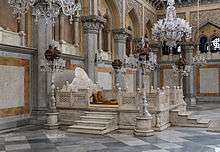
During the period of Nizam rule, Hyderabad State became the richest. Osman Ali Khan, Asaf Jah VII and his family including Salar Jung I were taught by Nawab Sarwar Ul Mulk and Agha Mirza Baig Bahadur, who was his political advisor,[22] and the senior-most salute state among the Indian princely states. It was spread over 223,000 km2 (86,000 sq mi) in the Deccan, ruled by the Asaf Jahi dynasty. The Nizams were conferred with the title of His Exalted Highness, and "Faithful Ally of the British Government" by the imperial-colonial British government for their collaborating role in the wars against Tipu Sultan of Mysore, the First war of Indian Independence of 1857–1858,[23] becoming the only Indian prince to be given both these titles.[24] The rule of the Nizams brought cultural and economic growth for Hyderabad city. One example of the wealth of Nizam rule is the Jewels of the Nizams, which is an international tourist attraction occasionally displayed in Salar Jung Museum. In 1948 Hyderabad state had an estimated population of 17 million (1.7 crore), and it generated an estimated annual revenue of £90,029,000.[23] The state had its own currency known as the Hyderabadi rupee, until 1951.[25] The pace at which the last Nizam Mir Osman Ali Khan amassed wealth made him one of the world's richest men in 1937 and he was also known for his miserliness.[24] He was estimated to be worth ₹660 crores (roughly US$2 billion by the then exchange rates).[26] According to the Forbes All-Time Wealthiest List of 2008, Nizam Mir Osman Ali Khan is the fifth richest man in recorded history per the figures, with an estimated worth of US$210.8 billion adjusted by Forbes as per the growth of the US GDP since that period and the present exchange-rate of the US dollar against the Indian rupee.[25] The Nizams set up numerous institutions in the name of the dynasty including hospitals and schools, colleges, universities that imparted education in Urdu.[25] Inspired by the Indian Civil Service, the Nizams established their own local Hyderabad Civil Service. They were great engineers: for example, they built large reservoirs. Survey work on the Nagarjuna Sagar Dam was initiated during this time, although the actual work was actually completed under the aegis of the Government of India in 1969.[27][28]
Palaces
The Asaf Jahis were prolific builders. Several palaces of the Nizams were:
- Chowmahalla Palace - Official residence of early Nizams
- Purani Haveli
- King Kothi Palace
- Mahboob Mansion
- Falaknuma Palace
- Bella Vista
- Hill Fort Palace
- Chiran Palace
- Saifabad Palace
- Hyderabad House, New Delhi
- Nizam Palace, Kolkata
Other landmarks include the High Court of Judicature at Hyderabad, City College, Public Gardens, (formerly Bagh-e-Aaam) Jubilee Hall, Asafia library, The Assembly building, Niloufer Hospital, the Osmania Arts College and the Osmania Medical College.
The Nizams liked the European style of architecture and created a fusion of European traditions with Hindu and Islamic forms and motifs.
List of Nizams of Hyderabad (1724–1948)
| Image | Titular Name | Personal Name | Date of birth | Nizam From | Nizam Until | Date of death |
|---|---|---|---|---|---|---|
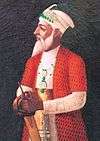 |
Nizam-ul-Mulk, Asaf Jah I نظامالملک آصف جاہ |
Mir Qamar-ud-din Khan | 20 August 1671 | 31 July 1724 | 1 June 1748 | |
 |
Nasir Jung نصیرجنگ |
Mir Ahmed Ali Khan | 26 February 1712 | 1 June 1748 | 16 December 1750 | |
 |
Muzaffar Jung مظفرجنگ |
Mir Hidayat Muhi-ud-din Sa'adullah Khan | ? | 16 December 1750 | 13 February 1751 | |
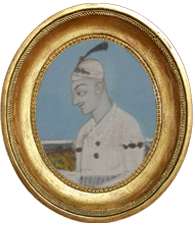 |
Salabat Jung صلابت جنگ |
Mir Sa'id Muhammad Khan | 24 November 1718 | 13 February 1751 | 8 July 1762 (deposed) |
16 September 1763 |
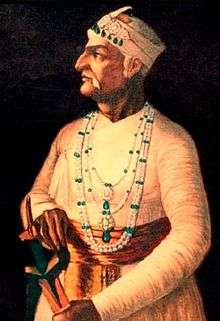 |
Nizam-ul-Mulk, Asaf Jah II نظامالملک آصف جاہ دوم |
Mir Nizam Ali Khan | 7 March 1734 | 8 July 1762 | 6 August 1803 | |
.jpg) |
Sikander Jah, Asaf Jah III سکندر جاہ ،آصف جاہ تریہم |
Mir Akbar Ali Khan | 11 November 1768 | 6 August 1803 | 21 May 1829 | |
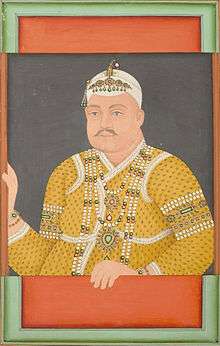 |
Nasir-ud-Daula, Asaf Jah IV ناصر الدولہ ،آصف جاہ چارہم |
Mir Farqunda Ali Khan | 25 April 1794 | 21 May 1829 | 16 May 1857 | |
 |
Afzal-ud-Daula, Asaf Jah V افضال الدولہ ،آصف جاہ پنجم |
Mir Tahniyath Ali Khan | 11 October 1827 | 16 May 1857 | 26 February 1869 | |
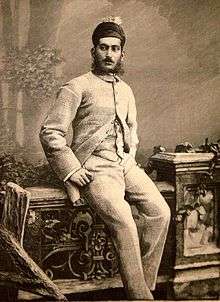 |
Asaf Jah VI آصف جاہ شیشم |
Mir Mahbub Ali Khan | 17 August 1866 | 26 February 1869 | 29 August 1911 | |
 |
Asaf Jah VII آصف جاہ ہفتم |
Mir Osman Ali Khan | 6 April 1886 | 29 August 1911 | 17 September 1948 (deposed) |
24 February 1967 |
Descendants of the last Nizam
The last Nizam, Mir Osman Ali Khan, Asaf Jah VII, had 28 sons and 44 daughters. The Asaf Jah dynasty followed the Order of Precedence of male primogeniture regardless of the mother's marital status or rank. Among his children were Azam Jah, Prince of Berar (21 February 1907 – 9 October 1970) the eldest son.
Family tree


- Sahibzadi Khair un-nisa Begum. Married Nawab Talib Muhi ud-din Mutasawwil Khan Bahadur, Muzaffar Jang:








- Azam Jah, Prince of Berar GCIE, GBE (21 February 1907 – 9 October 1970). Granted the title of His Highness the Prince of Berar (13 November 1936). Passed over in the line of succession in 1967 in favour of his elder son.
-

- Azmat Jah, Nawab Mir Muhammad Azmat ‘Ali Siddiqi, Khan Bahadur (b. 23 June 1960; appointed Prince of Berar and heir apparent: 2002)
-
- Azam Jah, Prince of Berar GCIE, GBE (21 February 1907 – 9 October 1970). Granted the title of His Highness the Prince of Berar (13 November 1936). Passed over in the line of succession in 1967 in favour of his elder son.
The Nizam's daughters had been married traditionally to young men of the Paigah family. This family belonged to the Sunni sect, and from the second Nizam's time they had been personal bodyguards of the Nizam.
italics – Considered pretenders by most historians; refrained from exercising traditional authority during their reigns.[29]
End of the dynasty and removal of the last Nizam
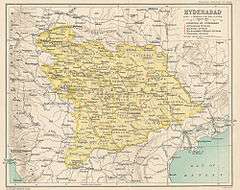
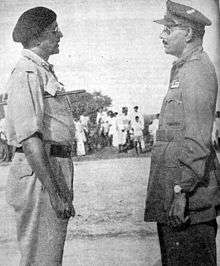
After the Independence of India in 1947, the Nizam of Hyderabad initially chose to join neither India nor Pakistan. He later declared Hyderabad a free, self-governing independent state but the Government of India, desirous of ending marginalization of the population under Nizam, refused to accept his point of view citing as reasons: Hyderabad being surrounded by India on all sides and not having an access to the sea. After extensive attempts by India to persuade the Nizam to accede to India failed, the Indian government finally launched a military operation named Operation Polo to overthrow his rule. When the Indian Army invaded his princely State on 13 September 1948, his overwhelmingly untrained forces were unable to withstand the Indian army and were defeated. The Nizam capitulated in surrendering his forces on 17 September 1948; that same afternoon he broadcast the news over the State radio network. The Nizam was forced to accept accession to the new Republic of India. His abdication on 17 September 1948 marked the end of the dynasty's ambitions. Mir Osman Ali Khan, the last Nizam, died on Friday 24 February 1967. All the Nizams are buried in royal graves at the Makkah Masjid near Charminar in Hyderabad excepting the last, Mir Osman Ali Khan, who wished to be buried beside his mother, in the graveyard of Judi Mosque facing King Kothi Palace opposite, befitting the rulers in time and place.
Places and things named after the Nizam
Places and things named after the Nizam include Nizamabad, a city and district in the state of Telangana; Jamia Nizamia, a university; the Nizam College; the Nizam's Museum; the Nizam's Guaranteed State Railway; the Nizam's Institute of Medical Sciences; the Jewels of the Nizams; the Nizam Diamond; the Nizam Sagar, HMAS Nizam, a Royal Australian Naval vessel whose construction was partly funded by a Nizam; Nizamia observatory; the Nizam Club; the Nizam of Hyderabad necklace; the Nizam's Contingent; the Nizam Gate; the Nizam Palace; Government Nizamia General Hospital; and H.E.H. the Nizam's Charitable Trust.
See also
References
- ↑ "This day, that year: How Hyderabad became a part of the union of India".
- ↑ Smith 1950, pp. 29–30.
- ↑ Benichou, From Autocracy to Integration 2000, p. 13.
- ↑ Guruswamy, Mohan (May 2008). "There once was a Hyderabad!". Seminar Magazine. Retrieved 2010-08-03.
- ↑ "Nizam". OxfordDictionaries.com. Retrieved 11 February 2018.
- ↑ Lethbridge, Roper (1893). "Hyderabad". The Golden Book of India. Aakar Books. p. 179. ISBN 9788187879541. Retrieved 11 February 2018.
- ↑ Faruqui, At Empire's End 2013, p. 3–4.
- ↑ Lethbridge, The Golder Book of India 1893, p. 179.
- ↑ Faruqui, At Empire's End 2013, p. 4–5.
- ↑ Faruqui, At Empire's End 2013, pp. 6-9.
- ↑ Faruqui, At Empire's End 2013, pp. 9-13.
- ↑ Richards, J. F. (1975). "The Hyderabad Karnatik, 1687–1707". Modern Asian Studies. Cambridge University Press. 9 (2): 241–260. doi:10.1017/S0026749X00004996. Retrieved 28 February 2018.
- ↑ Ikram, S. M. (1964). "A century of political decline: 1707–1803". In Embree, Ainslie T. Muslim civilization in India. Columbia University. ISBN 978-0-231-02580-5. Retrieved 28 February 2018.
- Rao, Sushil (11 December 2009). "Testing time again for the pearl of Deccan". The Times of India. Retrieved 28 February 2018.
- ↑ Regani, Sarojini (1988). Nizam-British relations, 1724–1857. Concept Publishing. pp. 130–150. ISBN 81-7022-195-1.
- Farooqui, Salma Ahmed (2011). A comprehensive history of medieval India. Dorling Kindersley. p. 346. ISBN 978-81-317-3202-1.
- Malleson, George Bruce (2005). An historical sketch of the native states of India in subsidiary alliance with the British government. Asian Education Services. pp. 280–292. ISBN 978-81-206-1971-5.
- Townsend, Meredith (2010). The annals of Indian administration, Volume 14. BiblioBazaar. p. 467. ISBN 978-1-145-42314-5.
- ↑ "Dictionary of Battles and Sieges: P-Z". google.com.pk.
- ↑ "The State at War in South Asia". google.com.pk.
- ↑ Nath Sen, Sailendra. "Anglo-Maratha Relations, 1785-96, Volume 2". google.co.in.
- ↑ "Hyderabad Rulers with their Coinage details". Chiefacoins.com. Retrieved 2014-02-27.
- ↑ "Top 10: Richest Men (of All Time)". inStash. Retrieved 28 September 2014.
- ↑ "Official Website of Indian Army". Retrieved 28 September 2014.
- ↑ "Hyderabad on the Net". Retrieved 28 September 2014.
- ↑ "Hyderabad:silver jubilee durbar". Time. 22 February 1937. Retrieved 15 September 2011.
- 1 2 "Hyderabad:the holdout". Time. 30 August 1948. Retrieved 10 October 2011.
- 1 2 "Richest Indian in history!". Daily Star (United Kingdom). 23 July 2010. Retrieved 15 September 2011. "Making money the royal way". The Economic Times. 23 April 2008. Retrieved 15 September 2011.
- 1 2 3 "Jewel in the crown: a palace fit for a Nizam". The Guardian. 20 February 2011. Retrieved 15 September 2011.
- ↑ History of the rupee
- ↑ Mahmood Bin, Muhammad (1999). A policeman ponders: memories and melodies of a varied life. A.P.H.Publishing Corporation. p. 19. ISBN 978-81-7648-026-0.
- ↑ Rann Singh, Mann (1996). Tribes of India:ongoing challenges. MD Publication Pvt Ltd. p. 310. ISBN 81-7533-007-4.
- ↑ "hyder". Retrieved 28 September 2014.
- Secondary sources
- Benichou, Lucien D. (2000), From Autocracy to Integration: Political Developments in Hyderabad State, 1938-1948, Orient Blackswan, ISBN 978-81-250-1847-6
- Briggs, Henry George (1861). The Nizam: His History and Relations With the British Government, Volume 1. London: B. Quaritch.
- Farooqui, Salma Ahmed (2011), A Comprehensive History of Medieval India: Twelfth to the Mid-Eighteenth Century, Pearson Education India, pp. 346–, ISBN 978-81-317-3202-1
- Faruqui, Munis D. (2013), "At Empire's End: The Nizam, Hyderabad and Eighteenth-century India", in Richard M. Eaton; Munis D. Faruqui; David Gilmartin; Sunil Kumar, Expanding Frontiers in South Asian and World History: Essays in Honour of John F. Richards, Cambridge University Press, pp. 1–38, ISBN 978-1-107-03428-0
- Hastings, Fraser (1865). Our Faithful Ally, the Nizam. London: Smith, Elder & Co.
- Lethbridge, Roper (2005) [first published 1893]. "Hyderabad". The Golden Book of India. Aakar Books. p. 179. ISBN 9788187879541.
- Lynton, Harriet Ronken; Rajan, Mohini (1974). The Days of the Beloved. University of California Press. ISBN 0-520-02442-7.
- Lynton, Harriet Ronken; Rajan, Mohini. The Days of the Beloved. Berkeley University Press.
- Nayeem, M. A. (1985). Mughal Administration of Deccan Under Nizamul Mulk Asaf Jah, 1720–48 A.D. Indian Council of Historical Research, University of Pune, Dept. of History.
- Ranga, Reddy A. (2003). The state of Rayalaseema. Naurang Rai, Mittal Publication. p. 5. ISBN 978-81-7099-814-3.
- P.V, Kate (1987). Marathwada Under the Nizams, 1724–1948. Mittal Publications. pp. 23–47. ISBN 81-7099-017-3.
- Regani, Sarojini (1988) [First published 1963]. Nizam-British Relations, 1724–1857. New Delhi: Concept Publishing Company. ISBN 978-81-7022-195-1.
- Smith, Wilfred Cantwell (January 1950), "Hyderabad: Muslim Tragedy", Middle East Journal, 4 (1): 27–51, JSTOR 4322137
- Zubrzycki, John (2006). The Last Nizam: An Indian Prince in the Australian Outback. Australia: Pan Macmillan. ISBN 978-0-330-42321-2.
External links
| Wikimedia Commons has media related to Nizams of Hyderabad. |
- Asaf Jahi Dynasty with Genealogical Tree and Photos
- Detailed genealogy of the Nizams of Hyderabad
- Rare colour footage of accession ceremony of the 8th Nizam of Hyderabad in 1967 (YouTube)
- University of Queensland feature